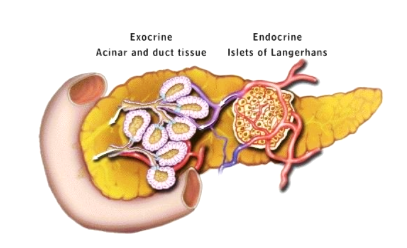
The islets of langerhans are found in
a. Liver
b. Pancreas
c. Stomach
d. Alimentary canal
Answer
576.9k+ views
Hint: Islets of Langerhans have titled after the German physician Paul Langerhans, who initially described them in 1869. The organ in which it is present contains about 1 million islets. The hormones secreted by the islets will directly enter into the blood flow. The patch-clamp technique is used to study the electrical activity of islets.
Complete answer:
Islets of Langerhans are produced in the pancreas. It is of four types of cells- alpha cells that ooze glucagon, β-cells that secrete insulin, delta cells that secrete somatostatin, and F cells that exude pancreatic polypeptide.
Islets of Langerhans, also known as islands of Langerhans, unevenly shaped patches of endocrine tissue located inside the pancreas of most vertebrates.

Hence, The correct answer is option (B).
Additional information:
The beta-cell produces insulin, the main hormone in the regulation of carbohydrate, fat, and protein metabolism. Insulin is critical in several metabolic processes:
- It encourages the uptake and metabolism of glucose by the body’s cells.
- It prevents the discharge of glucose by the liver.
- It causes muscle cells to uptake amino acids, the fundamental components of protein.
- It inhibits the breakdown and release of fats.
The alpha cells create an opposing hormone, glucagon, which releases glucose from the liver and fatty acids from fat tissue. Ultimately, glucose and free fatty acids support insulin release and inhibit glucagon release.
The delta cells release somatostatin, a strong inhibitor of somatotropin, insulin, and glucagon; its role in metabolic regulation is not yet clear.
Note: Somatostatin is also produced by the hypothalamus and works there to reduce the secretion of growth hormone by the pituitary gland.
The incapability of the islet cells to make insulin or the breakdown to produce quantity sufficient to manage blood glucose levels is the cause of diabetes mellitus.
Complete answer:
Islets of Langerhans are produced in the pancreas. It is of four types of cells- alpha cells that ooze glucagon, β-cells that secrete insulin, delta cells that secrete somatostatin, and F cells that exude pancreatic polypeptide.
Islets of Langerhans, also known as islands of Langerhans, unevenly shaped patches of endocrine tissue located inside the pancreas of most vertebrates.

Hence, The correct answer is option (B).
Additional information:
The beta-cell produces insulin, the main hormone in the regulation of carbohydrate, fat, and protein metabolism. Insulin is critical in several metabolic processes:
- It encourages the uptake and metabolism of glucose by the body’s cells.
- It prevents the discharge of glucose by the liver.
- It causes muscle cells to uptake amino acids, the fundamental components of protein.
- It inhibits the breakdown and release of fats.
The alpha cells create an opposing hormone, glucagon, which releases glucose from the liver and fatty acids from fat tissue. Ultimately, glucose and free fatty acids support insulin release and inhibit glucagon release.
The delta cells release somatostatin, a strong inhibitor of somatotropin, insulin, and glucagon; its role in metabolic regulation is not yet clear.
Note: Somatostatin is also produced by the hypothalamus and works there to reduce the secretion of growth hormone by the pituitary gland.
The incapability of the islet cells to make insulin or the breakdown to produce quantity sufficient to manage blood glucose levels is the cause of diabetes mellitus.
Recently Updated Pages
Master Class 12 Business Studies: Engaging Questions & Answers for Success

Master Class 12 Economics: Engaging Questions & Answers for Success

Master Class 12 English: Engaging Questions & Answers for Success

Master Class 12 Maths: Engaging Questions & Answers for Success

Master Class 12 Social Science: Engaging Questions & Answers for Success

Master Class 12 Chemistry: Engaging Questions & Answers for Success

Trending doubts
What is meant by exothermic and endothermic reactions class 11 chemistry CBSE

Which animal has three hearts class 11 biology CBSE

10 examples of friction in our daily life

One Metric ton is equal to kg A 10000 B 1000 C 100 class 11 physics CBSE

1 Quintal is equal to a 110 kg b 10 kg c 100kg d 1000 class 11 physics CBSE

Difference Between Prokaryotic Cells and Eukaryotic Cells




